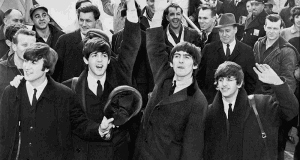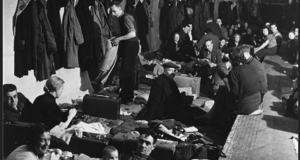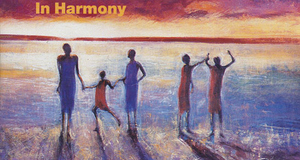What Riot? Punk Rock Politics, Fascism, and Rock Against Racism
By
2012, Vol. 4 No. 01 | pg. 1/2 | »
KEYWORDS:
The punk-rock movement or youth subculture of late seventies Britain was and is, even today, the cause of much controversy. It has often been accepted that the political orientation of the movement and its outcomes are decidedly located on the left wing, including, in particular, a strong anti-racist agenda. This has perhaps been emphasized in the public consciousness, particularly in light of recent retrospectives such as the 2007 film Joe Strummer: The Future is Unwritten, or the 2005 documentary Punk: Attitude. Both characterize punk as a movement with distinctly anti-authoritarian and cosmopolitan leanings, almost to the point of naiveté. A factor that is often uncritically referred to is the obvious relationship between punk rock or “new wave” and Rock Against Racism (RAR). RAR was an organization that was initially formed in response to a drunken outburst by Eric Clapton at a Birmingham concert in 1976, but which quickly developed into a dynamic movement that sought, with debatable success, to combat racism within British society at large. The romanticized leftism of punk may have as much to do with the emotional involvement of commentators as with a commercial imperative; the release of Joe Strummer: The Future is Unwritten, coincided with the re-release of Clash albums, one assumes in order to boost sales. Regardless, Roger Sabin, one of the more recent commentators on the history of punk politics, argues that this amounts to an orthodoxy within the history of punk, one that he sees the need to challenge. In a chapter entitled “‘I Won’t Let That Dago By:’ Rethinking Punk and Racism,” Sabin attempts to correct what he views as a myth concerning punk’s affiliation with anti-racist and left wing politics and ideas.1 There are two prongs to his argument. The first is a critique of the thoroughness and uniformity of punk’s involvement with anti-racism. Here Sabin emphasizes the selective nature of punk’s anti-racist stance: the plight of afro-Caribbean minorities was given priority whilst Asian immigrant communities remained largely alienated and ignored. This is a criticism that has also been made of Rock Against Racism itself, as events organized by the movement were virtually exclusively dominated by punk and reggae acts.2 The second part of Sabin’s argument focuses on actual incidents and examples of racism within the punk movement. Sabin cites instances of fascist or racist symbolism and lyrics, as well as flirtation or even outright affiliation between punk groups and racist organizations, predominantly the National Front (NF). Sabin argues that this amounts to a political ambivalence within punk rock, exploding the mythologized image of the movement as a genuine crusade against social and political injustice. My own views are less pessimistic, and my aim here is to respond to Sabin’s argument, whilst arguing for a more positive interpretation of the history of race politics and British punk. My argument unfolds in two parts. The first seeks to explain different characterizations of the punk movement. During the period in question, particularly the early years of 1976-77, punk was arguably ambiguous.3 Neither punks themselves nor their outraged onlookers were sure of what the political implications of the movement might be. Punk could be a blind, nihilistic rebellion, distinctly apolitical in its stance. At the same time there were fears that it would become oriented with the right, with neo-fascism and racism, or conversely that it had distinctly left-leaning tendencies. There are evidence and arguments to illustrate all three possibilities, though I am inclined towards the latter.The second part of my argument will draw on theories developed by sociologist of rock, Simon Frith, in order to argue that the widespread characterization of punk as a left-wing, progressive and anti-racist cultural movement, combined with its operation as a mass medium indicates that it was possessed of significant political clout. Due to internal political elements that I see as having achieved dominance within the movement, coupled with its association with RAR, I would argue that in spite of the criticisms leveled by Sabin, punk rock can indeed be viewed as an effective vehicle for anti-racism and the politics of the left, though the ultimate effect of this may well still be up for debate. That there existed a strong relationship between punk rock and race is not up for debate. Indeed this relationship was not even exclusive to the punk subculture. Dick Hebdige, in his 1979 book Subculture: The Meaning of Style, illustrates how successive waves of British working class youths sought to define and redefine their identities, their styles, in response to black immigration and culture.4 Teddy boys, mods and skinheads all adopted or rebounded off black style and music in their youthful rebellion against the constrictions of their class background. Punk in this sense was not unique. Whether in the form of imported rock & roll for the teddy boys or reggae for the punks, race relations are seen by Hebdige as central to post-war British youth culture. Furthermore, this relationship was an unsteady one: adoption of certain black cultural styles and forms does not entail racial harmony, as exemplified by the teddy boys’ often violent expressions of nationalism and anti-immigration sentiments. Influences from black culture were appropriated by working class youths during leisure time as material to fuel their youthful rebellion, but this did not mean that they shared an affinity with their new neighbors. Indeed Hebdige throws up two conflicting points in relation to punk. Firstly, he identifies the movement as the only subculture in his study to come close to an open exchange with black immigrant culture. Punks unashamedly championed reggae music, and Hebdige even cites involvement in RAR, as well as violent clashes between punk and the nationalistic teddy boys as evidence of punk anti-racism.5 Nevertheless, this union is seen by Hebdige as an uneasy one, as the resulting punk style is so different to that of black reggae that it even appears to exist in conflict with black style. This is further illustrated by punks’ use of the swastika symbol. Hebdige does not see this as an active expression of racism, but as a determined desire to cause offense through the reappropriation of symbols, regardless of their connotations.6 This benevolent characterization has been criticized, both at the time and by commentators like Sabin.7 In any case, the overall picture of punk that one gets from Hebdige’s account only covers half the story, although it successfully highlights the ambiguity of punk rock from a political perspective. Hebdige is of course concerned with punk style. The resulting characterization focuses on the side of the subculture that first emerged, one might even argue dominantly, in relation to the activity of the Sex Pistols. This is, in my opinion, partially the result of Hebdige’s perspective as a cultural theorist rather than an historian and partially because in 1979, when the book was published, there was only half a story to tell anyway. Regardless, what one sees when looking through this perspective is an analysis of a new cultural form, whose subversive value, in line with the subcultures that came before it, stems from a reappropriation of symbols and signs designed to outrage older generations and the status quo in general. If punk differs from its predecessors, the mods and the teddy boys, it is because it goes further than any of them in centering its rebellion, not around an ironic adoption of ‘straight’ style as with mod suits, or around a romanticized working class style of denim and boots, as with the skinheads, but around an ever changing negation of values. This is what gives rise to the conception of punks as anarchists, or worse, nihilists, and the resulting political implications amount to a question mark: “no future in England’s dreaming”. Focusing on this aspect of punk, as I have said, highlights its political ambiguity, at least in the early days. Such an emphasis on punk style however, seems to neglect a lot of what punks actually said. When comparing the subculture in England with its American equivalents, that is, the music of Iggy Pop and the Stooges, the Ramones and the New York Dolls, to name a few, it seems abundantly clear that punk music in England, in contrast to the previous generation of rock and roll, was distinctly political in its inflection. This can be related directly to the issues resulting from the sense of political and economic crisis being faced more generally in Britain at the time, which incidentally can be seen as having contributed to a growth in racist rhetoric on the political scene. Recurring themes included criticisms of the status quo (“God save the queen/The fascist regime,” the Sex Pistols), lengthening dole queues and joblessness (“Career Opportunities” by the Clash), consumerism (see “Germ Free Adolescents” by X-Ray Spex), the constrictions of conformity (“Clampdown” by the Clash or “Smash It Up” by the Damned), race relations (“I Feel Like a Wog” by the Stranglers), police brutality (“In the City” by the Jam) and youth solidarity (“If The Kids Are United” by Sham 69). If punk style was politically subversive, then the actual message put forward in the music amounted to a criticism of almost every aspect of the society that these young people were living in. Of course this image has been played upon heavily since the subculture first began to feature on both music and gutter press front pages, and it has also received its fair share of criticism, not least from within the subculture itself, in addition to the likes of Roger Sabin and other detractors. It should be remembered that there is a distinct problem with viewing punk as a unified movement. Differences between bands are as common as similarities. Yet the degree to which punk music raised issues such as those named above is striking and contrasts deeply with both the American punk scene and the previous generation of rockers. In fact this last point is relevant in that a good deal of the impetus within the movement as well as its reception by music consumers could be related to the failure of the sixties and early seventies rockers to retain either their relationship with their audience or their status as rebellious. “Start the Revolution without John Lennon” was the headline of one NME article, for instance.8 The new wave was championed by many as a progressive, home-grown response to both a cultural and political void. Roger Sabin’s argument intersects here. As I have briefly outlined, his argument takes issue with the portrayal of punk as either left-wing or anti-racist. Sabin criticizes punk pretensions to anti-racism by stressing what one might call a tendency towards tunnel vision within the focus of such a political stance. The emphasis on west-Indian or African-Caribbean culture and experiences of racism excluded, amongst others, the large Asian immigrant population, who experienced the brunt of racial violence but who were not, in Sabin’s opinion, seen as ‘cool’ enough to attract support. The union between reggae culture and punk, expressed for example in the Clash’s cover of Junior Murvin’s hit Police and Thieves, amongst other examples of artistic fusion, as well as the large scale RAR gigs that saw bands from the two genres playing side by side resulted in a favoritism that left Asian youths feeling alienated. On the other hand, Sabin highlights incidents of actual racism expressed by punk bands and fans. Indeed there are frequent examples of articles in the music press that expressed fears of a neo-fascist resurgence resulting from the political void within punk, with the aforementioned use of the swastika as a central theme.9 This supports Sabin’s argument to a degree, as do his references to racist statements or gafs made by eminent personalities within the new wave. Amongst those named are Siouxsie Sioux of the Banshees and Bernie Rhodes, manager of the Clash, who was reported to have said “there’s a lot of Paki’s who deserve it” in relation to the topic of violent attacks on the Asian immigrant community.10 Sabin then goes on to give evidence of actual collaboration between punk bands and racist groups such as the National Front. Finally, he concludes by saying that despite the re-imagining of punk as a movement that largely championed the cause of anti-racism, it was essentially neutral both in its overall effect as well as its intentions.11Continued on Next Page » Suggested Reading from Inquiries Journal
Inquiries Journal provides undergraduate and graduate students around the world a platform for the wide dissemination of academic work over a range of core disciplines. Representing the work of students from hundreds of institutions around the globe, Inquiries Journal's large database of academic articles is completely free. Learn more | Blog | Submit Latest in History |
















